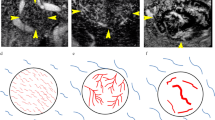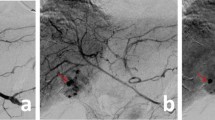Abstract
Objective: To evaluate the relationship between the efficiencies of subsegmental TAE and the expression of PCNA with ABC immunohistochemical staining in HCCs. Methods: Ultrasound-guided needle biopsies were performed in 43 patients (41 men, 2 women; age range: 32–75 years, mean, 55.6 years). PCNA were examined using ABC immunohistochemical staining. Tumor scores of PCNA were assessed by counting the positive nuclei per 1,000 cells. All the cases received subsegmental TAE with iodized oil and gelatin sponge. A correlation between the expression of PCNA and the efficiencies of subsegmental TAE was sought. Normality test, rank sum test and Chi-square test were used in statistical analyses with SAS package. Results: The mean PCNA labeling index was 58±29(range, 27–100%) in 43 patients. When compared with the macroscopic and pathologic parameters, PCNA labeling index was found to be significantly related to the presence and activity of cirrhosis. PCNA labeling index did not related to patients’ age, sex, HbsAg status or serum α-fetoprotein level. The PCNA labeling index corresponded to the degree of histological differentiation (Edmenderson-Steiner grading). The survival rates after subsegmental TAE were respectively 86.05%, 65.12% and 51.16% in one-, two- and three-years, and were significantly higher in the low labeling index group than that in the high labeling index group. Conclusion: The PCNA labeling index was shown to be closely related to histological characteristics and survival of the patients.
Similar content being viewed by others
References
Eto H, Toriyama K, Itakura H. A clinicopathological study of hepatocellular carcinoma in Nagasaki, south-western Japan: the association of hepatitis B and C viruses[J]. Southeast Asian J Trop Med Public Health 1994; 25: 88–92.
Bravo R, Celis JE. Aserach for differential polypeptide synthesis throughout the cell cycle of Hela cells[J]. J Cell Biol 1980; 84: 795–802.
Bravo R, Frank R, Blundell PA, et al. Cyclin/PCNA is the auxiliary protein of DNA polymerase-δ[J]. Nature 1987; 32: 515–7.
Inoue H, Ito T, Siraki K, et al. Effect of segmental transcatheter arterial chemoembolization on branched chain amino acids and tyrosine ratio in patients with hepatocellular carcinoma[J]. Int J Oncol 2000; 17: 977–80.
Wu PC, Lau VK, Fang JW, et al. Imbalance between cell proliferation and cellular DNA fragmentation in hepatocellular carcinoma[J]. Liver 1999; 19: 444–51.
Mise K, Tashiro S, Yogita S, et al. Assessment of the biological malignancy of hepatocellular carcinoma: relationship to clinicopathological factors and prognosis[J]. Clin Cancer Res 1998; 4: 1475–82.
Landberg G, Tan EM, Roos G. Flow cytometric multiparameter analysis of proliferating cell nuclear antigen/cyclin and ki-67 antigen: a new view of the cell cycle[J]. Exp Cell Res 1990; 187: 111–8.
Huang GT, Lee HS, Chen CH, et al. Tissue hepatocyte growth factor and proliferating cell nuclear antigen in hepatocellular carcinoma[J]. J Formos Med Assoc 1999; 98: 92–6.
Ng IO, Ng M, Fan ST. Better survival in women with resected hepatocellular carcinoma is not related to tumor proliferation or expression of hormone receptors[J]. Am J Gastroenterol 1997; 92: 1355–8.
Ebelt J, Neid M, Tannapfel A, et al. Prognostic significance of proliferation markers in hepatocellular carcinoma (HCC)[J]. Zentralbl Chir 2000; 125: 597–601.
Author information
Authors and Affiliations
Corresponding author
Additional information
Biography: LI Yu-liang(1970–), male, master of medicine, associate professor, the Second Hospital, Shandong University, Jinan, 250033, majors in the diagnosis and endo-vascular treatment of abdominal tumor.
Rights and permissions
About this article
Cite this article
Li, Yl., Shao, Gr. Relationship between efficencies of segmental hepatic artery chemoembolization and PCNA labeling index in HCC. Chin. J. Cancer Res. 16, 123–126 (2004). https://doi.org/10.1007/s11670-004-0010-1
Received:
Accepted:
Issue Date:
DOI: https://doi.org/10.1007/s11670-004-0010-1




